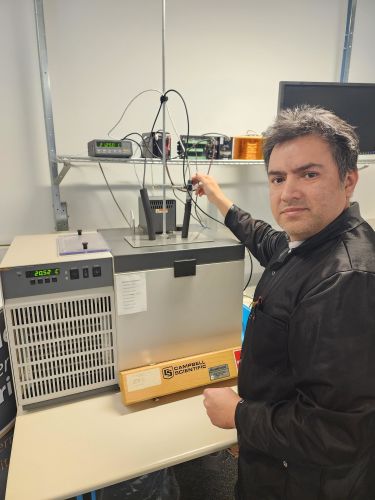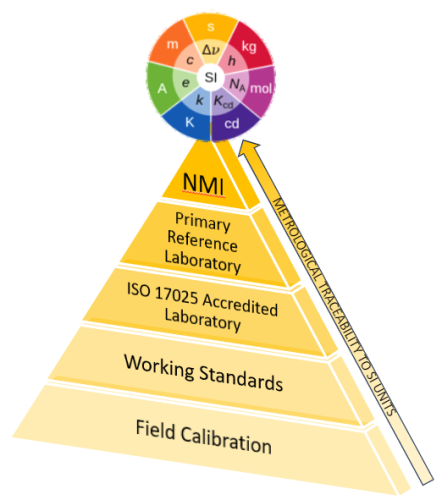Aspectos Esenciales de la Calibración: Trazabilidad
por Michael Jacobs | Actualizado: 03/18/2024 | Comentarios: 0

En nuestro artículo anterior sobre calibración, establecimos el papel crítico de la calibración para garantizar mediciones fiables y precisas en diversos campos. Examinamos la esencia misma de la calibración y su importancia para la seguridad, la eficiencia y la calidad. Ahora, en este segundo artículo, cambiamos el enfoque hacia la garantía de trazabilidad, un pilar para asegurar la confiabilidad de los resultados de las mediciones..
|
Recomendado para usted: Si se perdió nuestro primer artículo sobre calibración, "Aspectos Esenciales de la Calibración: Importancia," tómese un momento para leerlo ahora. |
Garantía de Trazabilidad en Mediciones Meteorológicas
Imagina un escenario donde las lecturas de temperatura de las estaciones meteorológicas varían ligeramente entre diferentes regiones. Esta inconsistencia puede llevar a pronósticos meteorológicos inexactos y plantear desafíos para comprender los patrones climáticos globales. La garantía de trazabilidad en las calibraciones ayuda a abordar esta preocupación.
¿Qué es la garantía de trazabilidad?
La garantía de trazabilidad establece una cadena ininterrumpida de comparaciones que vincula las lecturas de un dispositivo de medición con estándares reconocidos internacionalmente. Esta cadena normalmente involucra lo siguiente:
- Oficina Internacional de Pesos y Medidas (BIPM): Esta organización mantiene los estándares internacionales primarios de medición y es la sede del Sistema Internacional de Unidades (SI). Las unidades SI están en la cima de la jerarquía de trazabilidad a la cual debe vincularse la cadena ininterrumpida de comparaciones.
- Institutos Nacionales de Metrología (NMI): Estas instituciones actúan como la máxima autoridad para garantizar la precisión de las mediciones en sus respectivos países. Participan en comparaciones internacionales para garantizar que sus estándares sean consistentes con las referencias internacionales.
- Laboratorios de referencia primarios: : Este tipo de laboratorio calibra instrumentos utilizando estándares de referencia proporcionados por los NMI.
- Laboratorios acreditados por ISO/IEC 17025: Estos laboratorios proporcionan servicios de calibración trazables a estándares nacionales.

¿Por qué es importante la garantía de trazabilidad?
La garantía de trazabilidad minimiza la incertidumbre en las mediciones, fomentando la confianza en la validez de los datos. Esto es especialmente crucial en campos como la meteorología, donde los datos precisos y consistentes son fundamentales para los pronósticos meteorológicos, el monitoreo del clima y la investigación.
Niveles de Garantía de Trazabilidad
La siguiente guía de la Organización Meteorológica Mundial (OMM) proporciona una breve explicación de los diferentes niveles de garantía de trazabilidad:
- Trazabilidad totalmente asegurada (escenario objetivo) Este nivel de trazabilidad se logra mediante la calibración en laboratorios acreditados por ISO/IEC 17025-accredited laboratories 17025 y el seguimiento de calibraciones regulares de instrumentos. Esto garantiza el más alto nivel de confiabilidad en las mediciones.
- Trazabilidad asegurada (aceptable, pero se recomienda mejora): En este nivel, los laboratorios no acreditados realizan la calibración con equipos trazables a estándares acreditados. Aunque este nivel es aceptable, Campbell Scientific recomienda aspirar a la acreditación completa para mayor confianza.
- Trazabilidad parcialmente asegurada: Este nivel de trazabilidad seinspecciones de campo utilizando kits calibrados con trazabilidad certificada. Este enfoque ofrece cierto nivel de seguridad, pero requiere mejoras para aplicaciones críticas.
- Falta de trazabilidad Debido a la inherente falta de confiabilidad de las mediciones, Campbell Scientific no recomienda este enfoque.
Recomendaciones e Información Adicional
La OMM enfatiza la importancia de la trazabilidad para sus estados miembros. Por ejemplo:
- Se alienta a los Servicios Meteorológicos e Hidrológicos Nacionales (SMHN) a establecer o fortalecer sus capacidades de calibración para garantizar que las mediciones se alineen con los estándares internacionales.
- La calibración regular de instrumentos y la adhesión a sistemas de gestión de calidad, como ISO/IEC 17025, son esenciales para mantener la integridad de los datos.
Calibración en Campbell Scientific
En Campbell Scientific, comprendemos el papel vital de la garantía de trazabilidad en las mediciones científicas. Nuestros servicios de calibración son realizados por técnicos capacitados en fábrica que utilizan equipos trazables a estándares nacionales. Ofrecemos diversos métodos de calibración para adaptarnos a tus necesidades específicas, asegurando que tu recolección de datos se adhiera a los más altos niveles de precisión y confiabilidad.
Recuerda: Las mediciones consistentes y fiables son fundamentales para la toma de decisiones informadas y el éxito en diversos campos. Al implementar procedimientos de calibración adecuados, seguir los protocolos de trazabilidad establecidos y aprovechar la experiencia de proveedores como Campbell Scientific, puedes garantizar la integridad de tus datos de medición y contribuir a un mundo de información científica precisa y confiable.
Recursos adicionales
Para más información, puede consultar estos recursos:
- BIPM website
- CIPM Mutual Recognition Arrangement (CIPM MRA) website
- ILAC (international organisation for accreditation bodies operating in accordance with ISO/IEC standards) website
- ISO/IEC 17025 Testing and Calibration Laboratories website
Unas palabras finales
Espero que este artículo haya ayudado a ilustrar la importancia de la garantía de trazabilidad en tus mediciones meteorológicas. En el próximo artículo de esta serie, analizaremos más de cerca la frecuencia de calibración. Si tienes alguna pregunta o comentario, por favor, publícalo a continuación.
Créditos: Ramatoulaye Nabi, de Campbell Scientific, ha contribuido a este artículo.




 Michael Jacobs was the Manager of Calibration and Repair Services at Campbell Scientific, Inc. With expertise in DC/low-frequency measurements, he analyzed measurement uncertainty and quality standards such as ISO 9001, ISO 17025, ANSI Z540, and relevant JCGM documents. Michael was trained in the US Air Force Precision Measurement Equipment Laboratory AFMETCAL program and had more than 30 years’ experience in measurement science.
Michael Jacobs was the Manager of Calibration and Repair Services at Campbell Scientific, Inc. With expertise in DC/low-frequency measurements, he analyzed measurement uncertainty and quality standards such as ISO 9001, ISO 17025, ANSI Z540, and relevant JCGM documents. Michael was trained in the US Air Force Precision Measurement Equipment Laboratory AFMETCAL program and had more than 30 years’ experience in measurement science.
Comentarios
Please log in or register to comment.